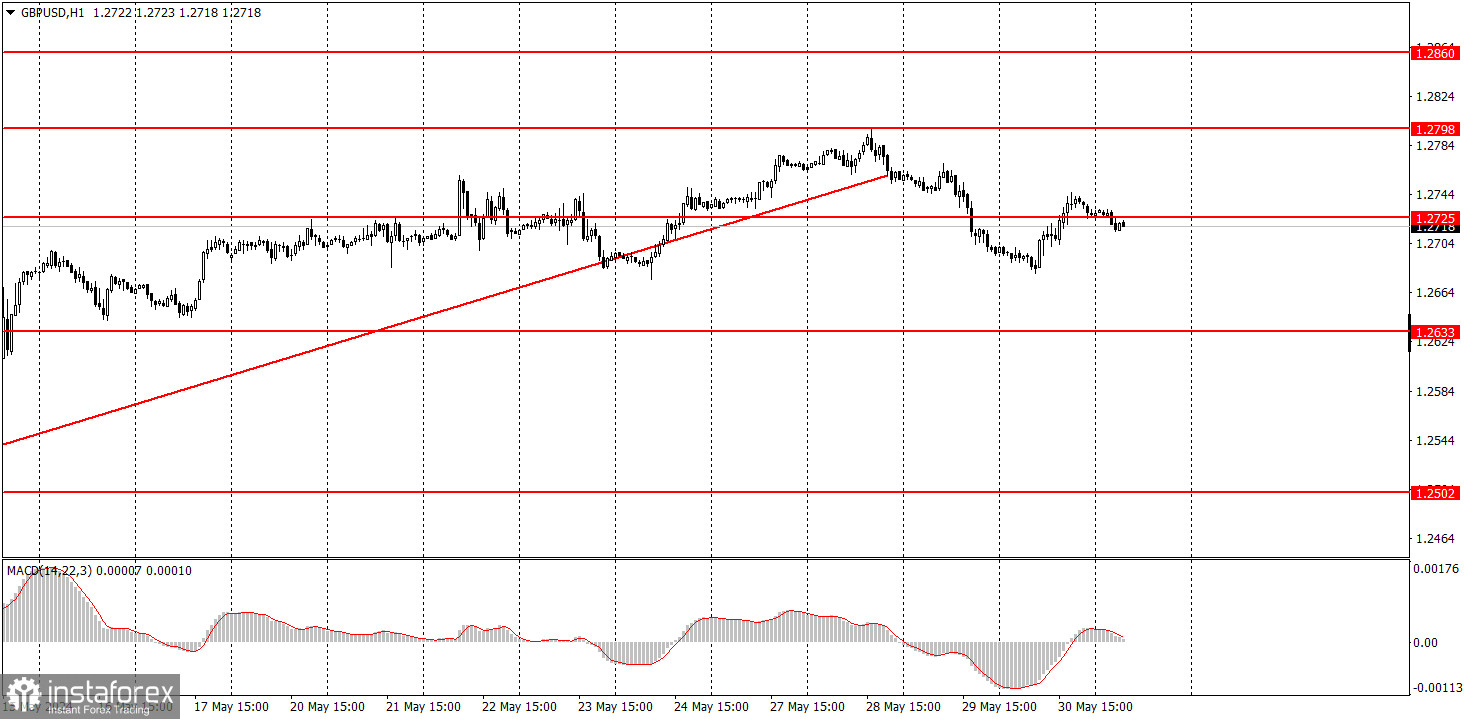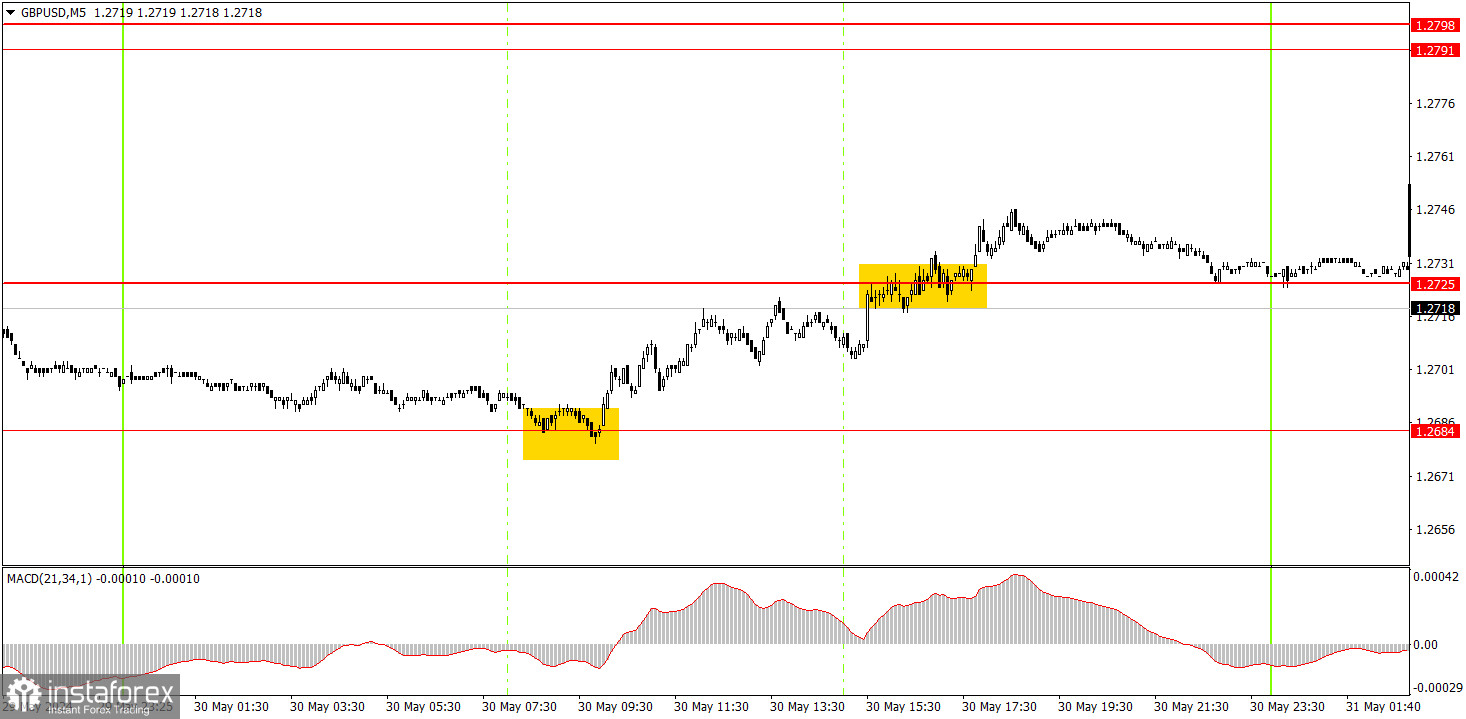Analyzing Thursday's trades:
GBP/USD on 1H chart

GBP/USD edged higher on Thursday, which was quite unusual. In the first half of the day, the pound had no fundamental reason to rise, and in the second half, the reasons were for formality's sake. However, the British currency started to rise long before the release of US macro data, which turned out to be less optimistic than expected. The second estimate of US Q1 GDP was revised lower to 1.3% below 1.6% in the advanced estimate. This matched the forecasts. Therefore, in general, the market had nothing to react to, as the slowdown in GDP was already expected. There was no significant deviation from the forecasts, but the US dollar still fell. We believe that this is just a coincidence, but there have been too many coincidences recently. The pound continues to rise often, even when there is no reason behind it.
GBP/USD on 5M chart

A good trading signal was formed around the level of 1.2684. It should have been executed with a long position. At the beginning of the US trading session, the pair also surpassed the level of 1.2725, so it was possible to stay in long positions. The trade could have been closed closer to the evening. The profit was about 45 pips.
Trading tips on Friday:
On the hourly chart, the GBP/USD pair has great prospects for forming a downward trend, but it could still correct higher. The fundamental backdrop continues to support the dollar much more than the British currency, but we have noticed that the pound rises quite often. The market interprets almost all the news in favor of the British currency.
Logically speaking, we expect the pound to fall on Friday, but considering the fact that the market doesn't need any reason to buy, the pound can still rise. A new consolidation below the level of 1.2725 may trigger a new downturn, which is unlikely to be strong.
The key levels on the 5M chart are 1.2372-1.2387, 1.2457, 1.2502, 1.2541-1.2547, 1.2605-1.2633, 1.2684, 1.2725, 1.2791-1.2798, 1.2848-1.2860. Today, there are no important events planned in the UK. The US will release reports on personal income and spending of the American population, as well as the Personal Consumption Expenditures (PCE) Price Index, which aren't crucial reports.
Basic trading rules:
1) Signal strength is determined by the time taken for its formation (either a bounce or level breach). A shorter formation time indicates a stronger signal.
2) If two or more trades around a certain level are initiated based on false signals, subsequent signals from that level should be disregarded.
3) In a flat market, any currency pair can produce multiple false signals or none at all. In any case, the flat trend is not the best condition for trading.
4) Trading activities are confined between the onset of the European session and mid-way through the U.S. session, after which all open trades should be manually closed.
5) On the 30-minute timeframe, trades based on MACD signals are only advisable amidst substantial volatility and an established trend, confirmed either by a trendline or trend channel.
6) If two levels lie closely together (ranging from 5 to 15 pips apart), they should be considered as a support or resistance zone.
How to read charts:
Support and Resistance price levels can serve as targets when buying or selling. You can place Take Profit levels near them.
Red lines represent channels or trend lines, depicting the current market trend and indicating the preferable trading direction.
The MACD(14,22,3) indicator, encompassing both the histogram and signal line, acts as an auxiliary tool and can also be used as a signal source.
Significant speeches and reports (always noted in the news calendar) can profoundly influence the price dynamics. Hence, trading during their release calls for heightened caution. It may be reasonable to exit the market to prevent abrupt price reversals against the prevailing trend.
Beginners should always remember that not every trade will yield profit. Establishing a clear strategy coupled with sound money management is the cornerstone of sustained trading success.
 English
English 
 Русский
Русский Bahasa Indonesia
Bahasa Indonesia Bahasa Malay
Bahasa Malay ไทย
ไทย Español
Español Deutsch
Deutsch Български
Български Français
Français Tiếng Việt
Tiếng Việt 中文
中文 বাংলা
বাংলা हिन्दी
हिन्दी Čeština
Čeština Українська
Українська Română
Română

